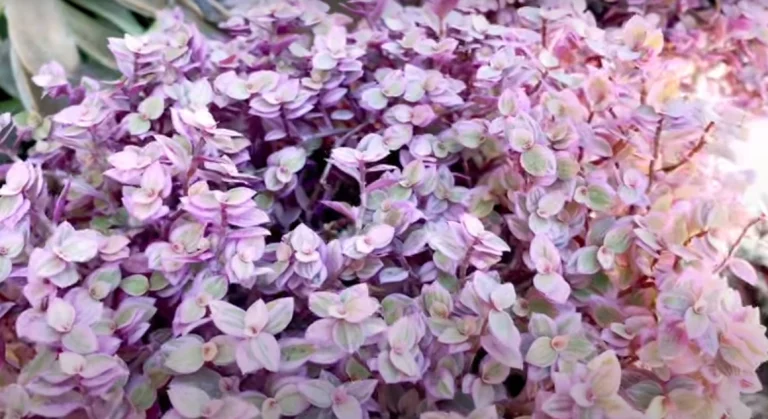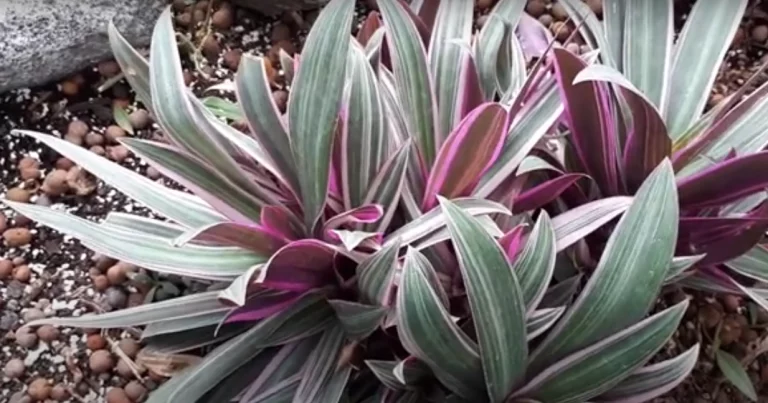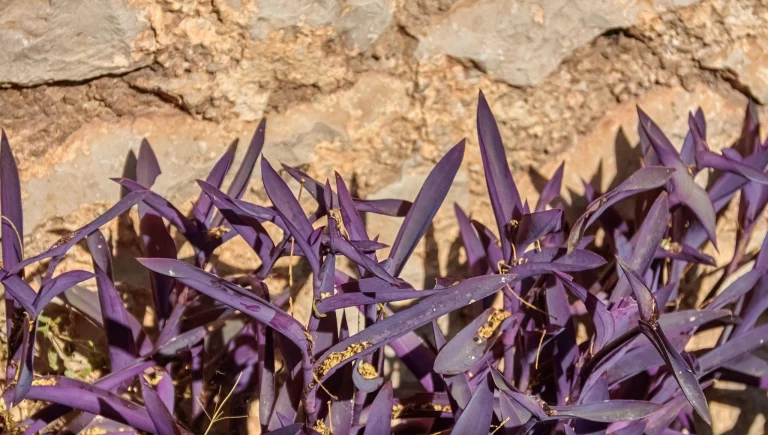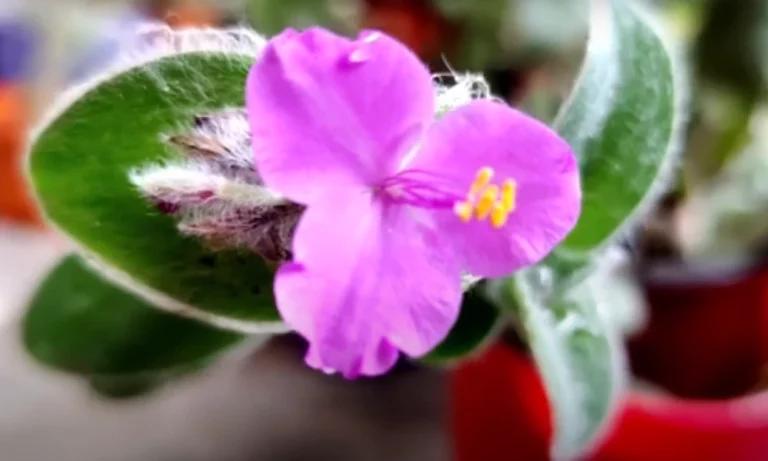Tradescantia Toxicity in Cats: Symptoms, First Aid and Prevention
Is Tradescantia Zebrina toxic to cats? The answer is yes, the Tradescantia Zebrina is toxic to our feline friends when ingested.
So what is it exactly in this plant that makes it so dangerous for cats? Let’s analyze its toxic compounds

Toxic Compounds in Tradescantia Zebrina
The main toxins found in the Tradescantia Zebrina that can cause problems are:
- Calcium oxalates: These are crystals that contain oxalic acid, which is very irritating to the mouth, tongue and throat when ingested. Tradescantia Zebrina contains them in the highest concentrations in the leaves.
- Saponins: These are soap-like chemical compounds that taste bad and can cause vomiting and diarrhea. Tradescantia Zebrina stems have saponins.
Additionally, cats can also have allergic reactions to the plant sap. So as you can see, the Tradescantia Zebrina plant is armed with an irritating chemical arsenal!
Now let’s move on to the dreaded part – what actually happens when a cat ingests these nasty plant toxins? 😿
Tradescantia Zebrina Toxicity Effects in Cats 😿
When ingested by cats, the toxins in the Tradescantia Zebrina can cause the following unpleasant symptoms:
- Oral Irritation: The calcium oxalates can cause painful irritation, swelling, drooling and burning sensations in the mouth and tongue.
- Gastrointestinal Distress: Vomiting, diarrhea, abdominal pain and loss of appetite are common.
- Difficulty Swallowing: Throat swelling due to irritation makes it very painful for kitties to swallow food or water.
- Breathing Issues: Severe irritation of mouth and throat can cause swelling and secretions that obstruct breathing. This needs immediate veterinary care!
In rare cases, it can even lead to collapse or tremors from the pain. So as you can see, Tradescantia toxicity is some serious business for cat owners! 😧
Now let’s analyze exactly what risk factors determine how severely it can affect cats. This will help us gauge the dangers better.
Tradescantia Zebrina Toxicity Risks for Cats?
While the effects of Tradescantia zebrina may sound quite scary, the level of danger depends on:
- Quantity Ingested: Large ingestions of leaves or stems cause more severe poisoning.
- Cat Size: Toxins affect smaller cats more strongly since there is less body mass for dilution.
- Cat Age: Kittens and old cats become sicker than healthy adults.
- Individual Sensitivity: Some cats may show milder or more severe symptoms.
So a tiny nibble by an adult cat might cause only minor drooling. But a curious kitten that munches on a whole leaf can end up with dangerous throat swelling! 😧
Severity can become life-threatening without prompt treatment in any cat that ingests a significant amount, no matter the size or age.
While mild cases often recover with supportive care at home, severe cases need hospitalization, oxygen support, intravenous fluids, pain management medication, sedation to insert a feeding tube, and antibiotics. Treatment can thus become very expensive too!
So in summary – yes, Tradescantia Zebrina is quite risky due to its potent chemical cocktails. Ingestion, especially of the leaves, should be treated as an emergency. Prevention is absolutely key!
Now that we’ve covered toxicity specifics and risks, let’s move on to discussing ways we can cat-proof our homes and keep Tradescantia safely out of paw’s reach! 🐾
Preventing Tradescantia Zebrina Poisoning in Cats
Now that we know this striped beauty poses some risks for cats, let’s talk about how we can have our Tradescantia without endangering our curious kitties. Prevention is key!
The main goal is keeping the plant fully out of reach from cats. Easier said than done right? 😅 Cats are agile and have a tendency to parkour to the most impossible spots! So here are some handy tips:
Smart Tradescantia Zebrina Placement
- Place in high shelves or hang in baskets totally inaccessible to feline jumps and swipes.
- Set valuable potted Tradescantia Zebrina in authentic vintage birdcages – adds great decor and keeps precious pets out!
- Grow them in outdoor gardens safely away from entryways.
Clever Household Cat-Proofing
- Use bitter anti-chew sprays made specially for household plant protection – cats hate the taste!
- Buy decorative ceramic and metal cat-proof planters so soil and roots are inaccessible.
- Use indoor greenhouse cabinets with locking doors to display Tradescantia zebrina safely.
Stubborn Cat Deterrents
For kitties who persistently parkour or bulldoze over to access toxic tropicals despite our best efforts? 😼
- Use motion-activated pet deterrents – they detect and emit a startling but harmless burst of compressed air.
- Install modular plastic carpet runners spike-side up around prized plants – cats dislike walking over the bumpy texture.
Whew, we have our work cut out with super smart kitties right? But being equally determined with cat-proofing tactics should do the trick!
Now, let’s talk about what to do if a mishap occurs despite preventions…
First Aid for Cats Poisoned by Tradescantia Zebrina 😱
Uh oh, every cat owner’s nightmare – you turn around for a minute and turn back to find a chomped crown of leaves and an incriminating cat! 😾 Now what?
Here are some first aid tips while rushing to the emergency vet:
Induce Vomiting
If ingested only within the last 2 hours:
- Call vet to get dose of 3% hydrogen peroxide based on weight
- Give with an oral syringe and massage throat
- Vomiting should occur in 10-15 minutes
Wipe Mouth
- Gently wipe inside of mouth to remove plant debris
- Avoid swallowing again
Emergency Veterinary Care
- Transport cat to vet ER immediately
- Inform type and quantity ingested
- Vet may induce further vomiting or give treatments
With toxins, seconds count for preventing absorption, so prompt action is key! Provide the vet details to guide correct care. With aggressive treatment, full recovery is very likely.
Phew! While extremely scary, even ingestion mishaps can turn out okay with calm prepared actions. Having essential first aid info can really make the difference. 😮💨
Now finally, if you decide Tradescantia Zebrina are too risky for your curious kitty, there are some safe non-toxic alternatives…
Cat-Friendly Alternatives to Tradescantia Zebrina
Here are some charming, 100% cat-safe alternatives to substitute our risky purple wandering wonder:
Feline-Friendly Foliage
- Spider plants – Cat grass! Easy care, air purifying and kitty approved nibbling.
- Boston ferns – Gorgeous arching fronds, thrives in low light.
- Prayer plants – Cool folding leaves, come in variegated varieties too.
For the Vertical Inclined
- Golden pothos – Gorgeous cascading vines, low maintenance.
- Arrowhead vines – Unfussy trailing vines with pretty leaves.
Quirky & Miniature
- Air plants – Weird, cute and zero soil for curious paws to dig in!
- African violets – Compact, colorful blooms and fuzzy leaves.
- Mini orchids – Endless variety! Secure with wires instead of toxic foams.
There we have it folks! With a bit of creative arrangement, we can safely have gorgeous plants in our cat-inhabited abodes. We just need some wise choices!
In Conclusion…
I hope this guide covered all things important about risks from Tradescantia Zebrina for cat owners!
To summarize:
✅ Yes it is toxic due to calcium oxalates and saponins
✅ Can cause moderate to severe irritation when ingested
✅ Prevention tactics are key to avoiding catastrophes!
✅ Act fast with first aid if a mishap occurs
✅ Many safer alternatives exist for cat owners!
You Might be interested in the following articles;
Tradescantia Sillamontana Medicinal Uses
Tradescantia Blossfeldiana ‘Bubble Gum’: Ultimate Care Guide




